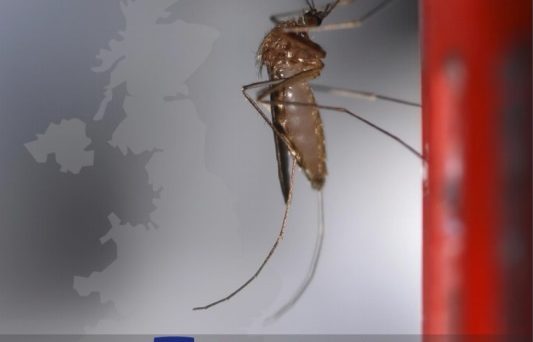
The third meeting on ‘Vector-Borne Diseases in the UK’ was held at The Foresight Centre, University of Liverpool in November. Held over a two-day period, the purpose of this biennial meeting is to bring together members of the major UK research groups who have an interest in vectors or vector-borne diseases which could be a threat to the UK, groups with wider but related areas of interest, members of key UK Government Departments and their Agencies, and representatives of European organisations with an interest in this topic.
The conference was kindly funded by the Health Protection Research Unit which was established in April 2014 using funding from the UK Government’s National Institute for Health Research (NIHR), as well as BBSRC, DEFRA, Oxford Biosystems and the Society for General Microbiology, allowing for a reduction in conference fees for PhD student attendees.
The first two meetings on this topic (held in 2012 and 2014) provided an excellent opportunity for UK researchers to share their current knowledge, identify important research gaps and expand their collaborations. With approximately 110 attendees, from the UK, USA, mainland Europe and Cyprus, this year’s meeting had an international feel with key talks given by members of groups with experience in the control of similar diseases overseas.
While a host of respectable entomologists, virologists, parasitologists and ecologists invaded Liverpool for the meeting, the UK has also had its own notable incursions (of diseases and their vectors) over the past few years. These have included new viruses, such as livestock diseases bluetongue and Schmallenberg, evidence of new vector species such as the eggs of the Asian tiger mosquito (Aedes albopictus) recently found near Folkestone, Kent, and 265 travel-associated cases of Zika diagnosed in the UK since 2015, with the first sexually transmitted case of Zika in the UK reported by Public health England (PHE) on 30th November 2016. This conference was a unique opportunity to bring specialists from different fields together to discuss vector-borne research in the context of the threat to the UK.
The meeting was divided into seven themes: vector-pathogen interactions, disease and vector ecology and surveillance, genetics and taxonomy, drivers of emergence, Zika, epidemiology and modelling, and surveillance and control; with talks delivered by both scientists and policy makers. Within the themes a variety of insect vectors were covered, including mosquitoes, aphids, ticks, Culicoides biting midges and whiteflies, along with a range of human, animal and plant pathogens, from Zika virus and malaria, to Babesia infection and bluetongue virus, to Tomato yellow leaf curl virus and phytoplasma infection (as seen in the much-adored Christmas poinsettia plants).
Research Highlights:
International Talks:
Four eminent Professors travelled from the USA to take part in the meeting, giving a unique slant on the research being undertaken in America on vector-borne diseases of humans, plants and animals. Shirley Luckhart from the University of California Davis (UC Davis) kicked-off the meeting, presenting her work on mitochondrial control of mosquito-malaria parasite interactions and tissue homeostasis. Also from UC Davis were Janet Foley and Bob Gilbertson, who gave informative talks on the emergence of tick-borne diseases, and the beet leafhopper (Circulifer tenellus)-transmitted Beet curly top virus, respectively. Finally, Alec Gerry from the University of California Riverside, challenges to using bait animals and artificial lures to assess biting insect activity.
Further experiences in the control and surveillance of diseases and vectors overseas were provided by Dr Angeliki Martinou from the joint Services Health Unit in Cyprus, who gave an informative overview of the current and previous efforts of an active surveillance scheme for native and invasive mosquitoes in the Sovereign Base Areas in Cyrus. Highlighting the challenges faced and lessons learned from integrated mosquito management approaches.
UK Talks:
Much work has been undertaken on the vector competence of British mosquitoes to numerous viruses. Dr Marcus Blagrove from the University of Liverpool presented studies assessing the competence of Aedes detritus, Culex pipiens, C. modestus and Culiseta annulata to dengue, chickungunya, West Nile, and Japanese encephalitis viruses, while Luis Dr Hernandez-Triana from the Animal and Plant Health Agency assessed C. pipiens and C. modestus for Usutu virus susceptibility. Their studies highlighted the relative differences in susceptibility for those viruses, but importantly highlighted their transmission capability, confirming the potential risk British mosquitoes may present for Arbovirus transmission in the UK.

A special session on Zika was scheduled for day two. Here, a range of speakers from some of the UK’s leading research teams, as well as Public Health England, gave an update on Zika research (Professor Tom Solomon, UoL), the UK’s response to the virus (Dr Katherine Russell, PHE), diagnostic and clinical challenges of working on Zika in Brazil (Dr Mike Griffiths, UoL), the development of mouse model for testing novel therapies (Steven Bryden, University of Glasgow), modelling work revealing the role of climatic factors in fuelling the south-American outbreak (Dr Cyril Caminade, UoL), and the UK’s invasive mosquito surveillance in
response to Zika (Dr Jolyon Medlock, PHE).
Dr Saskia Hogenhout, and her colleagues Dr Adi Kliot and Dr Melissa Tomkins, from the John Innes Centre, gave an insight into the importance of vector-borne diseases of plants. Myzus persicae, the green peach aphid transmits over 100 plant viruses and colonizes plant species from a diverse range of families. Hogenhout’s preliminary data highlights that these aphids are actively modulating plant processes in order to increase plant susceptibility and promote aphid colonization, by delivering virulence proteins while feeding from plants. Kliot however highlighted that another plant virus vector, the whitefly, Bemisia tabaci, harbours a secondary endosymbiont that influences virus transmission, with B. tahaci shown to transmit more viral particles of Tomato yellow leaf curl virus, be more attracted to infected tomato plants and have improved fecundity on infects plants when infected with Rickettsia.
The importance of Diptera in vector-borne diseases was discussed in a ‘non-traditional’ manner by Dr Martin Hall from the Natural History Museum. Here he described how female flies are the vectors of the eggs that give rise to parasitic larvae, thus can be considered ‘self-vectors’. Hall caught the attention of the whole audience with his graphic images showing the devastation caused by the sheep strike blow fly Lucilia sericata in the UK, the New and Old World screw worm flies Cochliomyia hominivorax and Chrysomya bezziana entering the UK living on humans, and the future threat to the UK from a flesh fly Wohlfahrtia magnifica, a major animal welfare and economically important fly of small ruminants in the Mediterranean Basis and central Eurasia, prone to range extensions.
Continuing the Dipteran theme, many behavioural and ecological studies were presented for both mosquitoes and Culicoides biting midges. Dr Victor Brugman from Evolution Biotechnologies highlighted that UK livestock farms support ornithophagic, mammalophagic and anthropophagic mosquito populations, with the candidate Arbovirus vector Culex species proven to feed on both resident and migratory birds – highlighting the risk of vector-borne disease transmission by UK mosquito species if there was disease incursion by migratory birds. With certain pathogens known to modify aspects of their hosts’ biology to further their own transmission, Ailie Robinson, from the London School of Hygiene and Tropical Medicine, highlighted her work on volatile olfactory cues may suggest a target for parasite manipulation, whereby identification of infection-associated odours may lead to further enhancement of traps for vector-borne disease surveillance and control.
Differing species of Culicoides biting midges, the vectors of bluetongue virus in livestock, have distinct host preferences, vector competences and parasitic or endosymbiont loads. The relative host preferences for sheep versus red deer were assessed by Stefanie Schӓfer from the Centre for Ecology & Hydrology, with C. obsoletus and C. scoticus equally abundant in light trap catches set next to sheep or red deer, while C. pulicaris was less frequently near red deer. Dr Georgette Kluiters from the University of Liverpool (UoL), highlighted the finding of a novel nematode parasitising UK Culicoides species that are vectors of bluetongue and Schmallenberg viruses. The presence of female nematodes carrying fertilised eggs whilst in the abdomen of Culicoides indicates a novel life-cycle of these nematodes in comparison to those previously studied in Culicoides, raising the questions as to their effect on fitness, survival and vector competence of the vectors.
The talks on tick vectors highlighted incursions of novel tick species and pathogens in the UK. Kayleigh Hansford, from Public Health England, highlighted recent importations of the Brown dog tick Rhipicephalus sanguineus to the UK, while Jessica Hall from the University of Salford emphasised that Borrelia miyamotoi, an emerging tick-borne pathogen recently detected in the UK for the first time, showed a consistent prevalence in southern Cumbria. Dr David Baines brought the conference to a close however, with some interesting methods on improving tick management aimed at restoring red grouse Lagopus lagopus scotica numbers, whose chicks are parasitised by the sheep tick Ixodes ricinus. Increasing the frequency of acaricide application and vaccination of sheep led to reduced tick biting rates on grouse and a decreased prevalence of louping-ill virus, reduced tick biting rates were also seen by fitting acaricide-impregnated leg rings to female grouse, while the use of pet dog acaricide-impregnated collars could extend persistence efficacy relative to widely used pour-on acaricide.
There were also a vast selection of thought-provoking posters including work

highlighting the feeding and attraction behaviour of UK mosquito species and prevalence of them on equine premises, the surveillance of ticks and Lyme disease across the UK, and the use of tick cell lines for isolation and propagation of intracellular bacteria, to name just a few.
One final thought: one vector-borne disease of plants mentioned during the meeting that is seen as a desirable and economically important plant pathogen in some cases, and is particularly relevant at this time of year, is

phytoplasma. The specialised bacterial infection by phytoplasmas causes the long-adored ‘Christmas’ poinsettia plants to branch more willingly, something which was not seen in poinsettia prior to 1970, so it is thanks to phytoplasma infection that these plants have more than one flower, as we see sold each Christmas.

One Comment